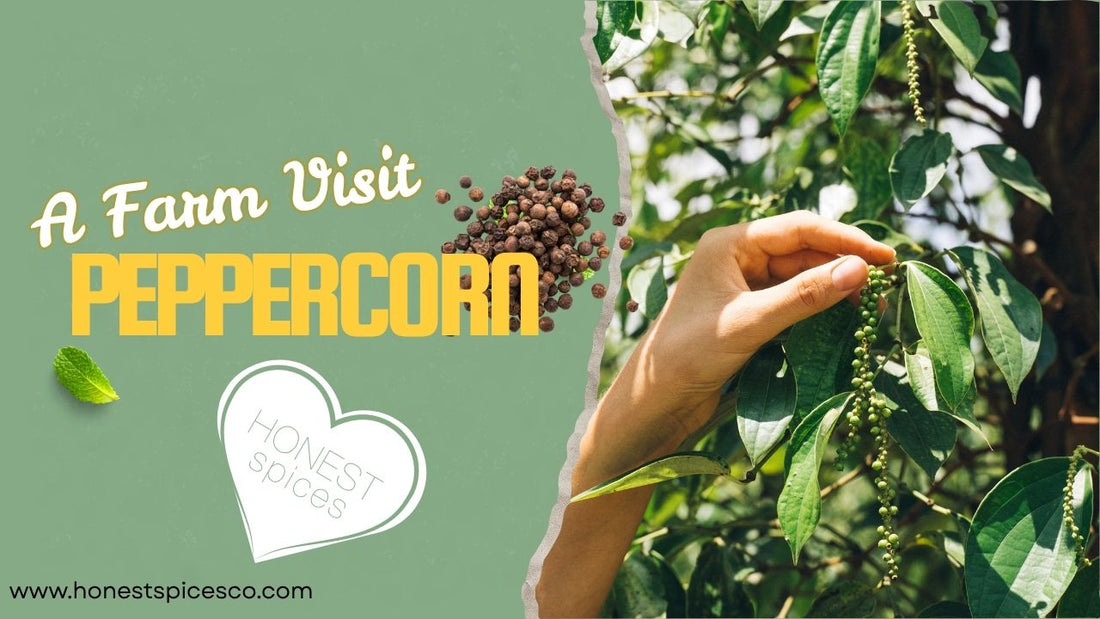
A Farm Visit - Peppercorn
Share
🌿 The Journey of Peppercorns: How They’re Grown and Why They’re Good for You
Often called the “king of spices,” peppercorns are a kitchen staple with a rich history and incredible versatility. But beyond their bold flavor and global presence lies a fascinating story of cultivation and natural health benefits. Whether you’re grinding black pepper onto your salad or adding a pinch to a simmering curry, you’re tapping into centuries of tradition and care.
🌱 How Peppercorns Are Grown
Peppercorns come from the plant Piper nigrum, a tropical vine that thrives in warm, humid climates. The plant produces clusters of small, round berries—what we know as peppercorns.
Here’s how they go from vine to spice rack:
- Planting the Vines: Pepper vines grow on poles or trees and take about 3–4 years to start producing fruit.
- Flowering and Fruiting: The plant flowers in spikes, which later turn into clusters of green berries.
- Harvesting: Timing is key—peppercorns are picked at different ripening stages depending on the type of pepper being produced.
- Drying and Processing: The berries are sorted, washed, and dried using sunlight or low heat to develop their final color, texture, and flavor.
⚫ Types of Peppercorns
Each color of peppercorn comes from the same plant, but the processing method and harvest time create different varieties:
- Black Peppercorns: Harvested when almost ripe and sun-dried until dark and wrinkled. They have a bold, sharp flavor.
- White Peppercorns: Fully ripe berries with the outer skin removed before drying. They have a milder, earthy taste.
- Green Peppercorns: Picked early and either freeze-dried or brined. These are fresher and more herbaceous.
- Pink or Red Peppercorns: Often from different species, like Schinus, and are fruitier and slightly sweet (not true Piper nigrum).
💪 Health Benefits of Peppercorns
Peppercorns are more than just seasoning—they’re a natural wellness booster used for centuries in traditional medicine.
- Digestive Support: Black pepper stimulates stomach acid production, aiding digestion and nutrient absorption.
- Rich in Piperine: This bioactive compound supports antioxidant activity and may enhance the absorption of nutrients like curcumin (from turmeric).
- Anti-Inflammatory Properties: Piperine may help reduce inflammation and joint discomfort.
- Immune-Boosting: Antioxidants in peppercorns help neutralize free radicals and support immune health.
- Metabolism & Circulation: Pepper may assist in increasing metabolism and improving blood flow.
🍽️ How to Use Whole Peppercorns
Whole peppercorns offer fresher, more intense flavor than pre-ground options—and they stay potent longer.
- Grind fresh over dishes for a burst of flavor
- Crack and toast for use in sauces, marinades, or rubs
- Infuse in soups, stews, or broths
- Use in brines and pickling for added depth
Pro tip: For best results, store whole peppercorns in a cool, dark place and grind them as needed.
✨ The Spice That Transforms
Peppercorns might be a common ingredient, but their journey from tropical vine to your table is anything but ordinary. Grown with care and packed with natural benefits, they bring bold flavor and functional value to every meal.
🛒 Want to elevate your cooking with premium whole peppercorns? Buy Now
